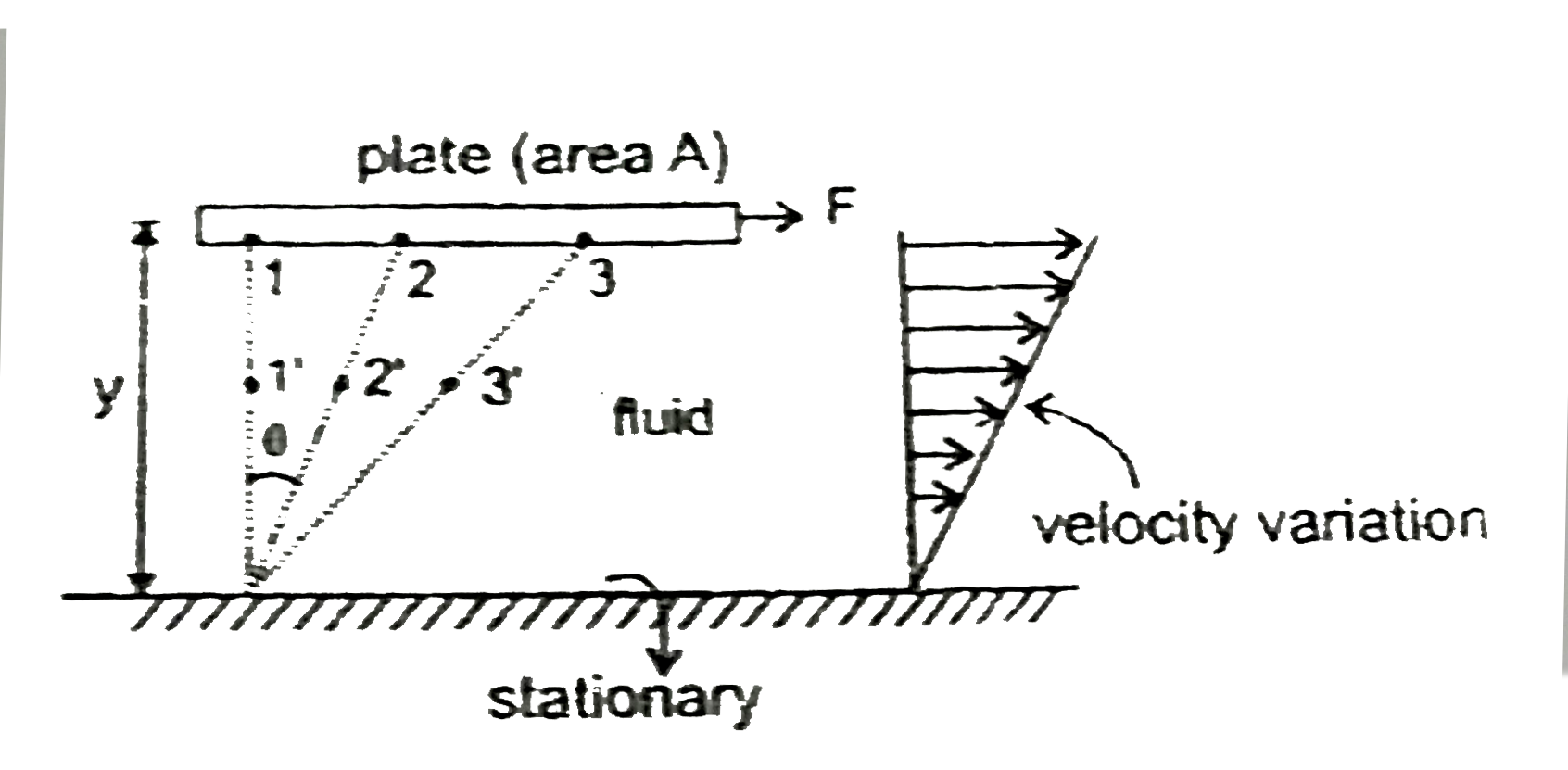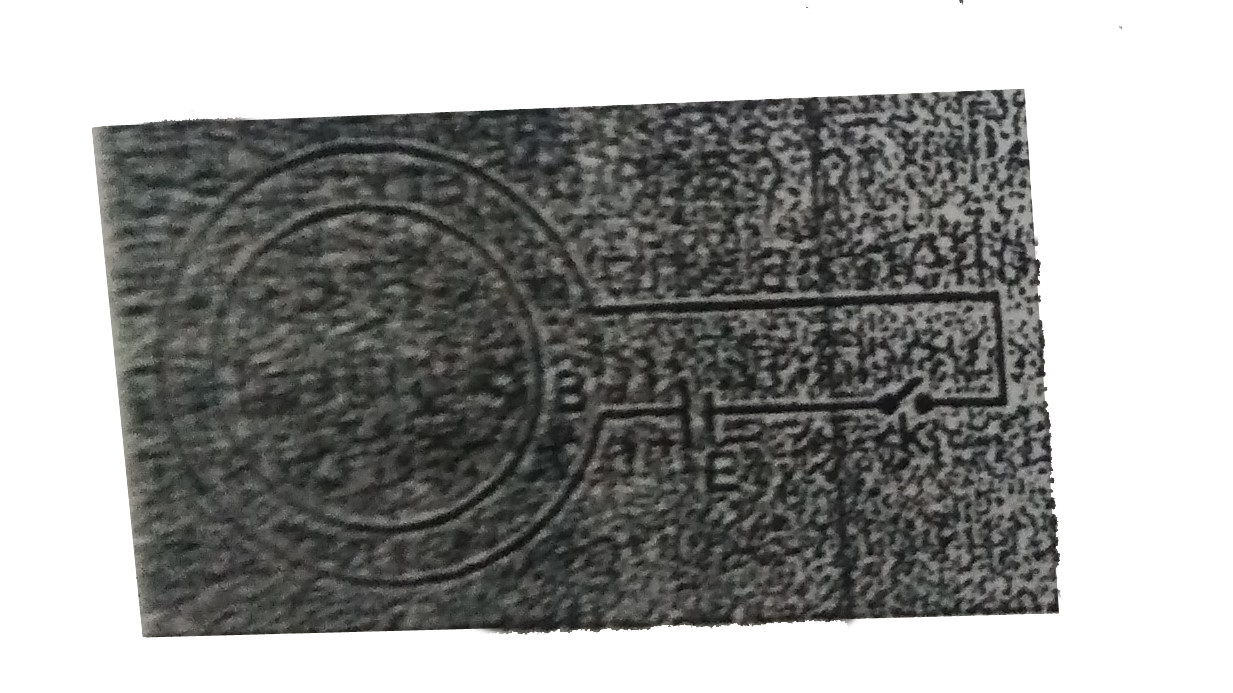Viscosity is the property of fluid by virtue of which fluid offers resistance to deformation under the influence of a tangential force.

In the given figure as the the plate moves the fluid particle at the surface moves from position 1 to 2 and so on, but particles at the bottom boundry remain stationary. if the gap between palte and bottom boundary is small, fluid particles in between plate and bottom moves with velocities as shown by linear velocity distribution curve otherwise the velocity distribution may be parabolic. As per Newton's law of viscity the tangential force is related to time rate of deformation -
FAαd'θdt but yd'θdt=u,d'θdt=uy
then F=ηAuy,η= coefficient of viscosity
for non-linear velocity distribution -
F=ηAdudy
where uy or dudy is known as velocity gradiant.
In previous question the value of constant speed of palte (m/sec.) is equal to
0
4
2
1
The correct Answer is:B
Step by step video, text & image solution for Viscosity is the property of fluid by virtue of which fluid offers resistance to deformation under the influence of a tangential force. In the given figure as the the plate moves the fluid particle at the surface moves from position 1 to 2 and so on, but particles at the bottom boundry remain stationary. if the gap between palte and bottom boundary is small, fluid particles in between plate and bottom moves with velocities as shown by linear velocity distribution curve otherwise the velocity distribution may be parabolic. As per Newton's law of viscity the tangential force is related to time rate of deformation - (F)/(A) alpha(d' theta)/(dt) but y(d' theta)/(dt)=u,(d' theta)/(dt) = (u)/(y) then F = eta A(u)/(y), eta = coefficient of viscosity for non-linear velocity distribution - F = eta A(du)/(dy) where (u)/(y) or (du)/(dy) is known as velocity gradiant. In previous question the value of constant speed of palte (m//sec.) is equal to by Physics experts to help you in doubts & scoring excellent marks in Class 11 exams.
Updated on:21/07/2023Topper's Solved these Questions
- ELASTICITY AND VISCOCITYBook:RESONANCEChapter:ELASTICITY AND VISCOCITYExercise:Exercise- 3 PART - I
Explore 7 Videos
- ELASTICITY AND VISCOCITYBook:RESONANCEChapter:ELASTICITY AND VISCOCITYExercise:Exercise- 3 PART - IV
Explore 9 Videos
- ELASTICITY AND VISCOCITYBook:RESONANCEChapter:ELASTICITY AND VISCOCITYExercise:Exercise- 2 PART - II
Explore 8 Videos
- DAILY PRACTICE PROBLEMSBook:RESONANCEChapter:DAILY PRACTICE PROBLEMSExercise:dpp 92 illustration
Explore 2 Videos
- ELECTROMAGNETIC INDUCTIONBook:RESONANCEChapter:ELECTROMAGNETIC INDUCTIONExercise:Exercise
Explore 43 Videos
Similar Questions
A small sphere falls from rest in a viscous liquid. Due to frication, heat is produced. Find the relation between the rate of production of heat and the radius of the sphere at terminal velocity.
View SolutionSpherical balls of radius 'R' are falling in a viscous fluid of viscosity 'η' with a velocity 'v'. The retarding viscous force acting on the spherical ball is
View SolutionA rod 1m long is 10cm2 in area for a portion of its length and 5cm2 in area for the remaining. The strain energy of this stepped bar is 40% of that a bar 10cm2 in area and 1m long under the same maximum stress. What is the length of the portion 10cm2 in area.
View SolutionA spherical ball is moving with terminal velocity inside a liquid determine the relationship of rate of heat loss with the radius of ball.
View SolutionAs shown in the figure, the key K is closed, the direction of the induced current in the coil B will be -

View SolutionAssertion: The flow of fluid is said to be steady if at any given point, the velocity of each passing fluid particle remains constant. Reason: The path taken by a fluid particle under a steady flow is a streamline.
View SolutionAssertion: The shape of an automobile is so designed that its front resembles the stream line pattern of the fluid through which it moves.
Reason: The resistance offered by the fluid is maximum.
View SolutionViscosity is the property of fluid by virtue of which fluid offers resistance to deformation under the influence of a tangential force. In the given figure as the the plate moves the fluid particle at the surface moves from position 1 to 2 and so on, but particles at the bottom boundry remain stationary. if the gap between palte and bottom boundary is small, fluid particles in between plate and bottom moves with velocities as shown by linear velocity distribution curve otherwise the velocity distribution may be parabolic. As per Newton's law of viscity the tangential force is related to time rate of deformation - (F)/(A) alpha (d' theta)/(dt) but y = (d' theta)/(dt) = u, (d' theta)/(dt) = (u)/(y) then F = eta A(u)/(y), eta = coefficient of viscosity for non-linear velocity distribution - F = eta A(du)/(dy) where (u)/(y) or (du)/(dy) is known as velocity gradiant. In the given figure if force of 2N required to maintain constant velocity of plate, the value of constant C_(1), & C_(2) are -
View SolutionViscosity is the property of fluid by virtue of which fluid offers resistance to deformation under the influence of a tangential force. In the given figure as the the plate moves the fluid particle at the surface moves from position 1 to 2 and so on, but particles at the bottom boundry remain stationary. if the gap between palte and bottom boundary is small, fluid particles in between plate and bottom moves with velocities as shown by linear velocity distribution curve otherwise the velocity distribution may be parabolic. As per Newton's law of viscity the tangential force is related to time rate of deformation - (F)/(A) alpha (d' theta)/(dt) but y = (d' theta)/(dt) = u, (d' theta)/(dt) = (u)/(y) then F = eta A(u)/(y), eta = coefficient of viscosity for non-linear velocity distribution - F = eta A(du)/(dy) where (u)/(y) or (du)/(dy) is known as velocity gradiant. If velocity distribution is given as (parabolic) u = c_(1)y^(2) + c_(2)y + c_(3) For the same force of 2N and the speed of the plate 2 m//sec , the constant C_(1), C_(2) & C_(3) are
View SolutionViscosity is the property of fluid by virtue of which fluid offers resistance to deformation under the influence of a tangential force. In the given figure as the the plate moves the fluid particle at the surface moves from position 1 to 2 and so on, but particles at the bottom boundry remain stationary. if the gap between palte and bottom boundary is small, fluid particles in between plate and bottom moves with velocities as shown by linear velocity distribution curve otherwise the velocity distribution may be parabolic. As per Newton's law of viscity the tangential force is related to time rate of deformation - (F)/(A) alpha (d' theta)/(dt) but y = (d' theta)/(dt) = u, (d' theta)/(dt) = (u)/(y) then F = eta A(u)/(y), eta = coefficient of viscosity for non-linear velocity distribution - F = eta A(du)/(dy) where (u)/(y) or (du)/(dy) is known as velocity gradiant. The velocity gradient just below the plate, in above problem is equal to - (per second)
View SolutionViscosity is the property of fluid by virtue of which fluid offers resistance to deformation under the influence of a tangential force. In the given figure as the the plate moves the fluid particle at the surface moves from position 1 to 2 and so on, but particles at the bottom boundry remain stationary. if the gap between palte and bottom boundary is small, fluid particles in between plate and bottom moves with velocities as shown by linear velocity distribution curve otherwise the velocity distribution may be parabolic. As per Newton's law of viscity the tangential force is related to time rate of deformation - (F)/(A) alpha (d' theta)/(dt) but y = (d' theta)/(dt) = u, (d' theta)/(dt) = (u)/(y) then F = eta A(u)/(y), eta = coefficient of viscosity for non-linear velocity distribution - F = eta A(du)/(dy) where (u)/(y) or (du)/(dy) is known as velocity gradiant. The velocity gradient just near the bottom boundary is equal to -
View SolutionThe coefficient of viscosity n of a fluid moving steadily between two surfaces is given by the formula, f = nA(dV)/(dx) where f is the frictional force on the fluid, A is an area in the fluid and dV//dx is the velocity gradient inside the fluid at that area. The SI unit of viscosity coefficient n is given as.
View Solutionएक बर्तन की तली क्षेत्रफल A तथा इसमें भरे द्रव का घनत्व d एवं ऊंचाई h है द्रव का दाब कितना होगा
(i) बर्तन की तली पर
(ii) द्रव के ऊपरी पृष्ठ पर
View SolutionAssertion: Under steady flow the velocity of the particle of fluid is not constant at a point. Reason: Ideal fluids are compresssible.
View Solutionकिसी द्रव की तली में एक निशान 0.1 m ऊपर दिखाई देता है | यदि द्रव की गहराई 1 m है तो द्रव का अपवर्तनांक होगा
View Solution

